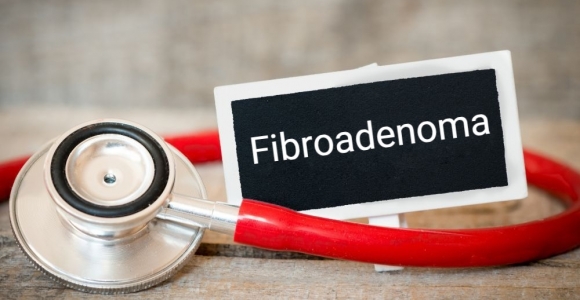A fibroadenoma feels like a firm, smooth or rubbery lump in the breast with a well-defined shape. A fibroadenoma is a noncancerous tumor in the breast that’s commonly found in women between the ages of 15 and 35. It’s painless and moves easily under the skin when touched. The tumor consists of breast tissue and stromal, or connective tissue. Fibroadenomas can occur in one or both breasts. Fibroadenomas develop from the lobules. The glandular tissue and ducts grow over the lobule to form a solid lump.
Sign and symptoms
- A lump that is hard, not movable, or feels attached to the chest wall, with or without pain, perhaps with dimpling or puckering of the breast, this may be a sign of breast cancer.
- A lump that is movable and feels unattached to the chest wall, is a cyst or a fibroadenoma.
- Pain or a feeling of fullness in one or both breasts, that’s not related to premenstrual swelling.
- Sometimes a painful lump, with or without redness, is the first sign of an infection.
- The masses may feel tender or painful, especially right before menstruation, when they may swell due to hormonal changes.
- Fibroadenomas are so mobile that women sometimes refer to them as “breast mice,” as they tend to run away from their fingers.
Types of fibroadenomas
In addition to simple fibroadenomas, there are:
- Complex fibroadenomas: These can contain changes, such as an overgrowth of cells (hyperplasia) that can grow rapidly. A pathologist makes the diagnosis of a complex fibroadenoma after reviewing the tissue from a biopsy.
- Juvenile fibroadenomas: This is the most common type of breast lump found in girls and adolescents between the ages of 10 and 18. These fibroadenomas can grow large, but most shrink over time, and some disappear.
- Giant fibroadenomas: These can grow to larger than 2 inches (5 centimetres). They might need to be removed because they can press on or replace other breast tissue.
- Phyllodes tumor: Although usually benign, some phyllodes tumors can become cancerous (malignant). Doctors usually recommend that these be removed.
Causes
The cause of fibroadenomas is unknown, but they might be related to reproductive hormones. Fibroadenomas occur more often during your reproductive years, can become bigger during pregnancy or with use of hormone therapy, and might shrink after menopause, when hormone levels decrease.
Risk factors
- Fibroadenomas are most common in women who are between 15 and 30 years old and in pregnant women.
- It is not seen after menopause unless using of hormonal therapy.
- Body mass index and the number of full-term pregnancies were found to have a negative correlation with the risk of fibroadenomas.
- There are no known genetic factors that influence the rate of fibroadenomas
Complications
Most fibroadenomas don’t affect your risk of breast cancer. However, your breast cancer risk might increase slightly if you have a complex fibroadenoma or a phyllodes tumor.
Diagnosis
During a clinical breast exam, the doctor will check both breasts for lumps and other problems. Some fibroadenomas are too small to feel, so they can only be discovered in imaging tests.
If have a lump that can be felt (palpable), the doctor might recommend certain tests or procedures, depending on the age and the characteristics of the lump.
Tests to evaluate the breast lump
Diagnostic mammography: Mammography uses X-rays to produce an image (mammogram) of suspicious areas in the breast tissue. A fibroadenoma might appear on a mammogram as a breast mass with smooth, round edges, distinct from surrounding breast tissue.
Breast ultrasound: This technology uses sound waves to produce pictures of the inside of the breast. Your doctor might recommend a breast ultrasound in addition to a mammogram to evaluate a breast lump if an individual have dense breast tissue.
For women younger than 30 who have a breast lump, the doctor likely will order a breast ultrasound first to evaluate the lump.
If a mammogram indicates that have a breast lump or other abnormality, a breast ultrasound might be used to further assess the lump. A breast ultrasound can help the doctor determine whether a breast lump is solid or filled with fluid. A solid mass is more likely a fibroadenoma; a fluid-filled mass is more likely a cyst.
Homeopathic treatment
Fibroadenoma is a curable condition with the use of natural Homeopathic medicines. Homeopathic treatment can prevent women from the surgical excision of the tumour from the breast. Surgery can remove the tumors in breast present at a particular time but the tendency to form tumours that are hidden in the body remains as such. Homeopathic treatment for Fibroadenoma of breast comes with a double benefit. The first is that Homeopathic medicines dissolve the tumours in the breast and the second is they help to reduce the body’s tendency to form such abnormal tumour growths by raising immunity. The entire dissipation of Fibroadenoma of breast takes a few months with the use of Homeopathic medicines. The selection of Homeopathic medicines varies for every individual.
Homeopathic medicines
Calcarea Fluor
Calcarea Fluor is the best Homeopathic medicine for treating Fibroadenoma of the breast where the nodes are as hard as a stone. Calcarea Fluor has a strong tendency to dissolve these hard knots in the breast. Wonderful results follow the use of Calcarea Fluor in women with stony hard nodes in the breast. These Breast Fibroadenomas get smaller and the hard lumps get softened, followed by complete disappearance with the use of Homeopathic Medicine Calcarea Fluor.
Conium
Conium is of great help in treating glandular affections. Conium can be used with excellent results to treat tumors in mammary glands. Conium is preferred in cases where nodes in the breast are present with pain in the breast before and during menstruation or periods. The pain usually gets worse upon touching. Homeopathic medicine Conium helps in treating both the cyclical appearance of breast pain around the menstrual nisus and also the diminution of breast nodes.
Phytolacca
Phytolacca is a natural Homeopathic medicine which can be very beneficial for the treatment of Fibroadenoma of the breast when inflammation of breast is associated with it. The breast is extremely sensitive, hard and painful. The glands in armpits may also get enlarged. In such cases, Homeopathic medicine Phytolacca provides a great helping hand in reducing the inflammation and pain in breast initially, followed by the complete disappearance of hardness.
Graphites
Graphites is a Homeopathic medicine which is of great help in treating Fibroadenoma in the breast. Homeopathic medicine Graphites is the best pick for treating tumors in the breast that arise from some old scars in the breast. Old scars may have remained after healing of abscess in the breast. Graphites work very efficiently in the dissipation of these tumors. The tumors, as well as the scars, disappear with this Homeopathy remedy.
Scrophularia Nodosa
Scrophularia Nodosa is a rare but very significant Homeopathic medicine that can be used for dissolving the tumors, lumps, nodes or indurations in breasts. This medicine is mainly used in tincture form. Scrophularia Nodosa is an extremely powerful Homeopathic medicine to dissolve and get rid of breast tumors. This Homeopathic medicine is absolutely safe with no side effects.
Pulsatilla
Pulsatilla is a natural Homeopathic medicine that can be taken when nodes in breast are accompanied by menstrual irregularities. The main menstrual irregularity noticed is suppressed menses for a long duration or scanty menses. Pulsatilla is of much help for girls at puberty suffering from lumps or nodes in breast.
Asteria rubens
It is indicated for breast swollen and pain; worse left side.

